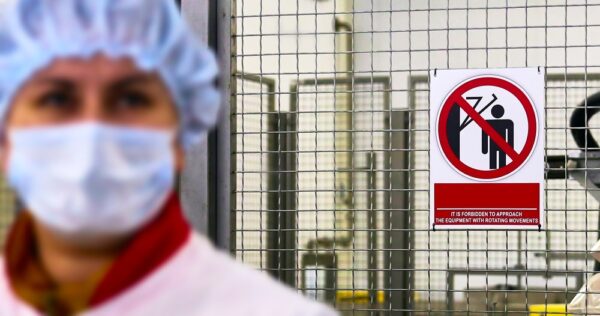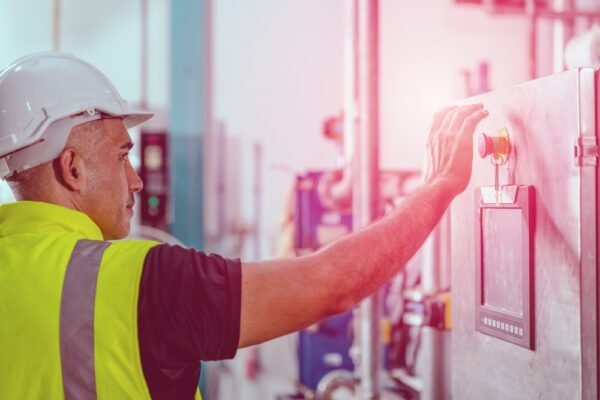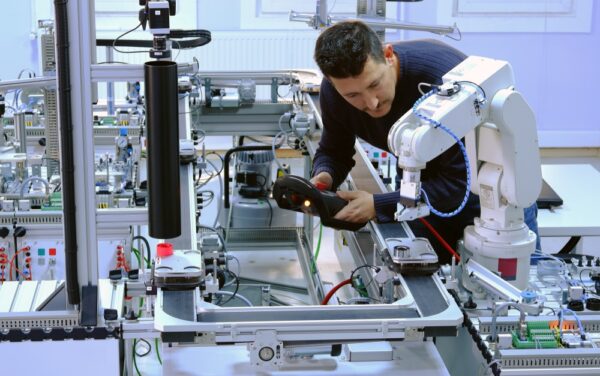Updated: July 2024
The safety gains of implementing an automated robot or industrial machine solution in your business are undeniable. Robots have revolutionized industries over the past three decades, allowing businesses to improve production capacity while reducing worker exposure to environmental hazards, aligning with robot safety best practices.
As the manufacturing sector increasingly embraces automation for high-turnover tasks, businesses are witnessing significant improvements in worker satisfaction and mental health outcomes.
However, integrating robots into workplaces where humans are present requires a good understanding of robotics safety. These powerful machines can often operate at high speeds and can use various tools (e.g., grippers, blades, stampers), all of which demand stringent robot safety guarding, thorough training, and specialized equipment.
It is paramount to safeguard against potential hazards, such as product mishandling or exposure to sharp, hot, or toxic materials.
This guide will look into the fundamental principles of industrial robot safety that you should consider, including insights into robot safety systems and relevant robot safety regulations.
Introduction to Robot Safety Best Practices

Robot safety guarding equipment can range from complex sensors to barriers and have built-in redundancies. Here are some common safety devices you might encounter when choosing your first automation project.
Barrier Guards
These physical obstructions are essential best practices designed to prevent employees from accidentally or intentionally entering unsafe zones around your automated machines.
- Fixed Guards: These permanent physical cages, also known as enclosing guards or perimeter guards, completely surround the robot’s work area. They offer a reliable layer of robot safety guarding, even with openings for material feeding. Fixed guards should be removable only with tools and must enclose all points of hazardous contact to comply with robot safety regulations.
- Interlocked Guards: These physical barriers, often gates or doors, act as critical robot safety resources by stopping all machine activity when opened. They prevent the robot from restarting until the interlock is reset (e.g., the door is closed) and a control system outside the hazardous zone is manually activated. This design allows for safe access to the machine for maintenance or adjustments without compromising overall robotics safety.
- Awareness Barriers: While not as protective as fixed or interlocked guards, awareness barriers are visual indicators to define a safety perimeter. These physical cues, such as low railings or chains, can be easily bypassed, so they should only be used in conjunction with other robot safety best practices or when risks are minimal.
Interested in learning more about how to implement these safety measures in your facility? Request a free consultation with DEVELOP LLC’s automation experts today.
Presence Detection Devices
These robot safety tools rely on area-based detection to provide an additional layer of safeguarding for machines. Often used in conjunction with physical barriers or as a substitute for them, these devices use the same interlock-style machine shutdown mechanism but offer easier access for maintenance by replacing solid barriers. These devices should be strategically placed outside the robot’s reach to ensure optimal safety.
- Light Curtains: These opto-electronic devices, a type of presence detection device, use a series of transmitters and receivers to create a screen of light. If a worker or object enters the light curtain and breaks the beams, the machine immediately shuts down.
- Pressure-Sensitive Safety Mats: As another type of presence detection device, these heavy-duty floor mats are equipped with pressure-sensitive plates that trigger a machine shutdown when detecting the weight of a person or object. Customizable in size and available in various styles, they offer versatile robot safety solutions.
Emergency Brakes

Emergency stop buttons or pull cords can be strategically placed within reach of everyone working with or near the machine. Responsive braking systems are integrated to swiftly halt all movement, counteracting the robot’s motion and preventing hazards like sudden drops of the robot arm. Even during power loss, the braked robot remains safely inoperative and will not automatically restart.
Control Devices
Also known as Human Machine Interfaces (HMIs), these panels, screens, or pendants serve as crucial robot safety resources, allowing the operator to control the robot effectively. To comply with robot safety regulations and best practices, these control devices should feature the following:
- Clear instructions and labeling
- Prominent emergency stops that lock the robot in the “off” position
- Status indicators reflecting the robot’s condition
- Control safeguards that prevent accidental activation.
For optimal safety, the main control panel or device is always located outside the hazard area, within sight of the robot, and serves as the sole location from which the robot can be reactivated.
Audible and Visual Warning Systems
These common worksite indicators are essential for ensuring safe robots and maintaining industrial robot safety. Lights, emergency tape, and clear signage should highlight the hazard area and communicate proper safety conduct around the robot.
Gauges, displays, and monitors should accurately reflect the robot’s condition, ensuring operators are aware of any potential issues. Separate emergency lights and audible alerts can also be used to quickly and effectively communicate emergencies.
Related Reading: Comprehensive Guide to the Industrial Automation Process
Robot Safety Regulations: Your Essential Guide

Understanding the complexities of robot safety regulations is crucial for ensuring the well-being of your workforce and maintaining compliance with industry standards. Various regulations govern the safe design, implementation, and operation of industrial robots. Here are the key robot safety regulations you need to be aware of.
ANSI/RIA R15.06-2012
The ANSI robot standard provides comprehensive guidelines for the safe design, integration, and use of industrial robots. It covers risk assessment, safeguarding measures, operator training, and maintenance/inspection procedures. Collaborating with your automation integrator can help ensure compliance with this standard.
OSHA 1910
While the Occupational Safety and Health Administration (OSHA) in the United States hasn’t yet established specific standards for the robotics industry, it emphasizes the protection of workers from hazards posed by industrial robots. OSHA’s general safety regulations and recommendations, including those related to lockout/tagout procedures (1910.147) and general machine safety (1910.212), apply to industrial robot safety.
ISO 10218
The International Organization for Standardization (ISO) has developed comprehensive industrial robot safety standards, including ISO 10218-2, focusing on systems, assembly lines, and automation. This standard was recently updated in 2022 to reflect advancements in robotics technology. While ISO standards are not mandatory in the US, many companies seek ISO certification to meet customer requirements or enhance their operations.
ANSI/RIA R15.08
In 2021, ANSI and the Robotic Industries Association (RIA) collaborated to create ANSI/RIA R15.08, a new standard specifically addressing the safety of mobile robots. This standard updated and replaced the outdated ANSI B56.5, providing comprehensive guidelines for the safe operation of mobile robots in industrial settings.
Not sure if automation is the right fit for your business?
Discover the potential benefits with our free Automation ROI Calculator.
Why is Safety Compliance Important?
Compliance with robot safety regulations isn’t only a legal obligation but also a moral responsibility. It ensures the safety of your workforce, reduces liability risks, and creates a productive work environment where humans and robots can collaborate effectively. By adhering to these standards, you demonstrate your commitment to worker safety and responsible automation practices.
Free eBook: The Transformative Impact of Automation for Manufacturers
Placement Tips for Optimal Robot Safety

Safeguarding your equipment goes beyond the implementation of safety devices. It also involves strategic placement of your robot to minimize risks and ensure compliance with robot safety regulations.
Securing Your Safe Robots
Your robot should be securely anchored to its designated location to prevent tipping, vibration, or movement even under maximum exertion. This not only protects workers but also ensures the robot’s longevity and optimal performance.
Environmental Considerations
It’s crucial to assess the environmental conditions of your facility and choose a robot model compatible with the temperature, humidity, and other factors present in the work area. Robots exposed to extreme temperatures or harsh environments may malfunction, posing safety risks and compromising productivity.
When selecting a suitable location for your robot, consider factors such as dust, debris, and potential for chemical exposure.
Accessibility for Maintenance and Repairs
Place your robot in a location that allows for easy access for maintenance and repair personnel. You need to be certain that routine checks and repairs can be carried out efficiently, minimizing downtime and reducing the likelihood of safety issues arising from neglected maintenance.
Clearance and Separation
Ensure there’s adequate clearance around the robot’s work area to prevent accidental collisions with workers or other equipment. Consider the robot’s range of motion and potential hazards when determining the appropriate safety distances. In some cases, physical barriers or safety zones may be necessary to further separate the robot from human workers.
Visibility
Position the robot in a way that allows operators and other personnel to maintain clear visibility of its movements and operations. This enhances situational awareness and enables quicker responses to any unexpected events or safety concerns.
Ready to explore the best layout for your automated workspace?
Contact DEVELOP LLC for a personalized consultation.
Safety Ownership: A Cornerstone of Robot Safety Best Practices
Effective accident prevention in industrial settings extends beyond technology and requires a proactive approach to safety ownership. Partnering with an automation integrator, such as DEVELOP LLC, is a crucial step in ensuring the safe and efficient operation of your industrial robots.
Through this collaboration, you get access to comprehensive training, education, and instruction on the responsible integration and operation of your automated machines. This comprehensive approach aligns with the ANSI robot standards, ensuring that your facility adheres to the highest safety benchmarks in the industry.
Operation Training
Supervisors, managers, and machine operators must undergo comprehensive training in the use, programming, and basic maintenance of your automated machine. This training is essential for understanding the rules of safe robot operation and responding effectively to potential hazards.
Related Reading: Guide to Essential Maintenance and Upgrades for Automated Systems
Safety Policy
Establish a written robotics safety policy that all employees must adhere to. This policy should outline safety protocols, hazard prevention measures, and access restrictions for operating the robot. Only fully trained operators or supervised trainees should be authorized to operate the robot, ensuring compliance with robot safety regulations.
Safety Checklists
Implement periodic condition checklists to assess the robot’s working condition regularly. You should also create a pre-operation safety checklist that includes a visual inspection and evaluation of gauges and screens before each activation. This proactive approach helps identify and address potential issues before they escalate into safety hazards.
Regular Maintenance
Integrating an automated machine into your business requires a commitment to regular and comprehensive maintenance. A poorly maintained machine can malfunction, jeopardizing not only production speed, consistency, and quality control but, more importantly, the safety of your workforce. Regular maintenance includes evaluating the machine’s condition, scheduling preventative maintenance, making necessary repairs promptly, and ensuring the longevity of your investment in safe robots.
Related Reading: Implementing Automation for Quality Control Improvements
in Manufacturing
Your Next Step to Successful Automation Integration
By prioritizing robot safety best practices and guarding techniques, and adhering to regulations like the ANSI robot standard, you can create a safe and productive work environment where humans and robots collaborate effectively.
Partnering with an experienced automation integrator can help you seamlessly integrate safety into your automation projects, ensuring the long-term success and safety of your operations.
With our expertise, we seamlessly integrate robot safety best practices into your operations, allowing your team to maintain ownership, expertise, and longevity in your automation journey. We offer comprehensive training programs, ensuring that your personnel are equipped with the knowledge and skills necessary to operate robots safely and efficiently.
Don’t leave robotics safety to chance. Take the first step towards a safer and more productive workplace by partnering with DEVELOP LLC. Schedule a virtual meeting, or call (262)-622-6104 to discover how we can help you automate your production today.
To explore your automation options further, take advantage of our free Automation Assessment questionnaire and discover if automation is the right fit for your facility. You can also use our ROI calculator to assess the financial viability of your automation investment.
Enter the future of automation with confidence, knowing that DEVELOP LLC is committed to your success and the safety of your workforce.
About the Authors:
Matt Moseman leads as President of DEVELOP, with a strong foundation from the Milwaukee School of Engineering, where he earned both a Bachelor’s and a Master’s in New Product Management. Moseman’s career highlights include his pivotal role in founding NodeUDesign, innovating in automation hardware, and driving DEVELOP LLC to the forefront of industrial robotics with a focus on enhancing productivity and efficiency.
Sean McKittrick, as Project Program Coordinator at DEVELOP LLC, brings a multifaceted background from Knox College. McKittrick’s first year at DEVELOP LLC has been marked by significant team growth and zero turnover, showcasing his ability to build a collaborative and effective work environment. His experience spans quality management in healthcare software to managing production for a million pounds of material monthly, highlighting his diverse expertise in project coordination and manufacturing excellence.

